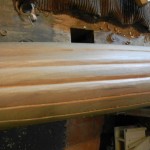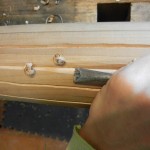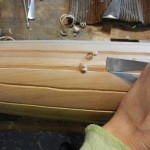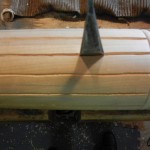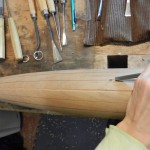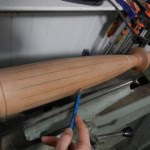- Partially finished reeds
- Using #4, 12mm to round over reeds
- Using flat chisel with bevel side down to get much of the wood away
- Defining straight line with straight chisel
- Carving lines with initial v-cut
- Using Indexing ring on lathe to locate lines
(I made a previous post and mistakedly called this carving “flutes”. I get to use the excuse that my carving teacher was Greek – it’s all greek to me?)
I have a project at the moment where I am hand-carving reeds on a turned leg. It would take longer to set up a router jig (which is where my husband’s expertise comes in) than it would to carve them, so I’m just going for it. If I had more than 2 legs to carve, I may have set up something mechanized. But, after all, I love to carve, so why not carve???
STEP 1:
I start out using an indexing ring on my lathe to draw the lines equal distance apart. My indexing ring has 48 points, so I decided to use every third one to get a total of 16 lines around my turned leg. What a great technique! Before I had a lathe, I just drew them on as accurately as possible, but the process of drawing on that many reeds and that long of a leg would have taken longer than the actual carving. And it would have been difficult to get them straight and accurate.
STEP 2:
Next, I took my 5mm v-chisel (60 degree angle) and carved down almost to the final depth of the groove down each of the lines (starting at 1/8″ and getting slightly shallower as the leg tapered toward the thinner bottom). As you can see in the photos, this is not an exact science, and the v-chisel can create a wavey line. The wood is cherry, so it was necessary to use a mallet to get the v-chisel down these lines. I use the v-chisel simply to get the bulk of the wood away so that when I make that final cut on that line with a flat chisel, it will eliminate any splitting of the wood. If I made that flat chisel cut as deep as I need without the initial v-chisel cut (I am cutting this 3/16″ at the deepest point) could damage the wood – not to mention I would have to hit it pretty hard to make it go that deep. Also, it would be more difficult to gauge the depth.
STEP 3:
Next, I take the largest flat chisel I have and make as straight of a cut as I can down the length of the line – I end up cutting slightly deeper than the depth I will round it over to – just to assure that it will be a nice clean, sharp corner.
STEP 4:
Next I take a straight chisel, a #3, 12mm, and a #4, 12mm and with a combination of all of these, I round over the reeds. I use the flat chisel when the other curved gouges dig in if they are cutting upside down. When I use the flat chisel, I use the bevel towards the wood because it allows me to lift the chisel off the wood and not have my hand crowded between the chisel and wood. Occasionally I am able to use the curved gouges upside down to actually utilize the curved shape (here is one argument for making a slight bevel on the inside of the gouge – it allows you to lift the gouge off the wood a little higher)
STEP 4:
Then, when all is finished, I take a VERY fine riffler file and run it down the groove, and sand the reeds smooth (since this is cherry, I need to be very careful not to leave sanding marks). I try to get the shaping done with the gouges and just remove any facets with the sand paper.
This technique of carving also works if you are carving that classical fan design. Using the straight chisel (as long as it is cut in a straight line without it wandering off) ensures a clean line. If the v-cut goes off a little (step 2), straighten it out with the flat chisel (step 3).
Now, the trick is to keep the same curvature and depth all the way around. So often if you have many reeds to carve, by the time you get to the other side and meet the first one you carved, they are completely different! As you carve them, you get the technique down, you get more confident, you go deeper, the shape changes slightly, and then you have to go back and fix the first ones…
And then to make two legs the same… well, you won’t ever be looking at 2 legs at the exact same time, so you can get away with some things…

